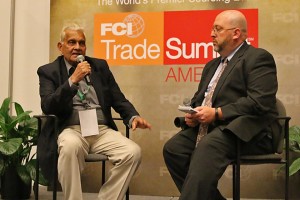Indian Export and Domestic Crop Protection Markets Continue to Grow
 Pradeep Dave, president of Pesticide Manufacturers and Formulators Association of India and chairman of AIMCO Pesticides Inc., has seen about as much of the Indian crop protection industry as any one. After all, he was instrumental in creating the country’s export market.
Pradeep Dave, president of Pesticide Manufacturers and Formulators Association of India and chairman of AIMCO Pesticides Inc., has seen about as much of the Indian crop protection industry as any one. After all, he was instrumental in creating the country’s export market.
Dave, who participated in the FCI Trade Summit – Americas’ inaugural Media Center event in Las Vegas, began his career in 1965 when he joined Gujarat Agrochem Industries in Ahmedabad after graduating from Mumbai University. Three years later he started his career at AIMCO.
“We started as pesticide formulators,” Dave said. “I joined this company to look after the production. Slowly we started doing backward integration.”
Dave moved up the ranks of AIMCO, and in 1990, was appointed managing director of AIMCO Pesticides Limited, a newly formed company to set up plant to manufacture technical-grade pesticides. Dave continues to focus on the $3.5 billion Indian crop protection market.
“India’s pesticide market is a growing,” Dave said. Of that, a little more than $1.5 billion is export a nd the balance is domestic. India’s crop protection market has shown annual growth of 12% to 15%.
nd the balance is domestic. India’s crop protection market has shown annual growth of 12% to 15%.
“There is a big opportunity in India,” Dave says. Around the world growers use nearly 3 kilograms of crop protection inputs per hectare. In India that figure comes in at about 700 grams/hectare.
“There’s a lot of opportunity,” he said. “Indian manufacturers are able to provide farmers with quality products at a competitive price.”
Dave sees equal opportunity for growth in both the domestic market and the export market. Currently there are between 15 and 20 companies doing contractual work for various multinationals.
That wasn’t always the case. Previously, multinationals weren’t willing to utilize the services and facilities of Indian manufacturers because there was no patent protection, Dave said. Of course, no matter how focused and well-planned the business strategy and how fine-tuned the manufacturing processes, certain factors are out of the industry’s control. Weather has a huge impact on the crop protection market. India is currently facing what has, so far, been a drier monsoon season. In some areas the rainfall deficiency is at 16%. In certain places people are still waiting for the rain. “Hopefully in August we will be able to make good,” Dave says.
If the monsoon rains make up for the deficiencies, then the sale of pesticides and fertilizers should hit their targets.
“August and September we expect some good rains,” he says.





